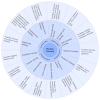Machine-Learning-Based Disease Diagnosis: A Comprehensive Review
- PMID: 35327018
- PMCID: PMC8950225
- DOI: 10.3390/healthcare10030541
Machine-Learning-Based Disease Diagnosis: A Comprehensive Review
Abstract
Globally, there is a substantial unmet need to diagnose various diseases effectively. The complexity of the different disease mechanisms and underlying symptoms of the patient population presents massive challenges in developing the early diagnosis tool and effective treatment. Machine learning (ML), an area of artificial intelligence (AI), enables researchers, physicians, and patients to solve some of these issues. Based on relevant research, this review explains how machine learning (ML) is being used to help in the early identification of numerous diseases. Initially, a bibliometric analysis of the publication is carried out using data from the Scopus and Web of Science (WOS) databases. The bibliometric study of 1216 publications was undertaken to determine the most prolific authors, nations, organizations, and most cited articles. The review then summarizes the most recent trends and approaches in machine-learning-based disease diagnosis (MLBDD), considering the following factors: algorithm, disease types, data type, application, and evaluation metrics. Finally, in this paper, we highlight key results and provides insight into future trends and opportunities in the MLBDD area.
Keywords: COVID-19; artificial neural networks; convolutional neural networks; deep learning; deep neural networks; diabetes; disease diagnosis; heart disease; kidney disease; machine learning; review.
Conflict of interest statement
The authors declare no conflict of interest.
Figures










References
-
- McPhee S.J., Papadakis M.A., Rabow M.W., editors. Current Medical Diagnosis & Treatment. McGraw-Hill Medical; New York, NY, USA: 2010.
-
- Ahsan M.M., Siddique Z. Machine Learning-Based Heart Disease Diagnosis: A Systematic Literature Review. arXiv. 20212112.06459 - PubMed
Publication types
LinkOut - more resources
Full Text Sources
Other Literature Sources

